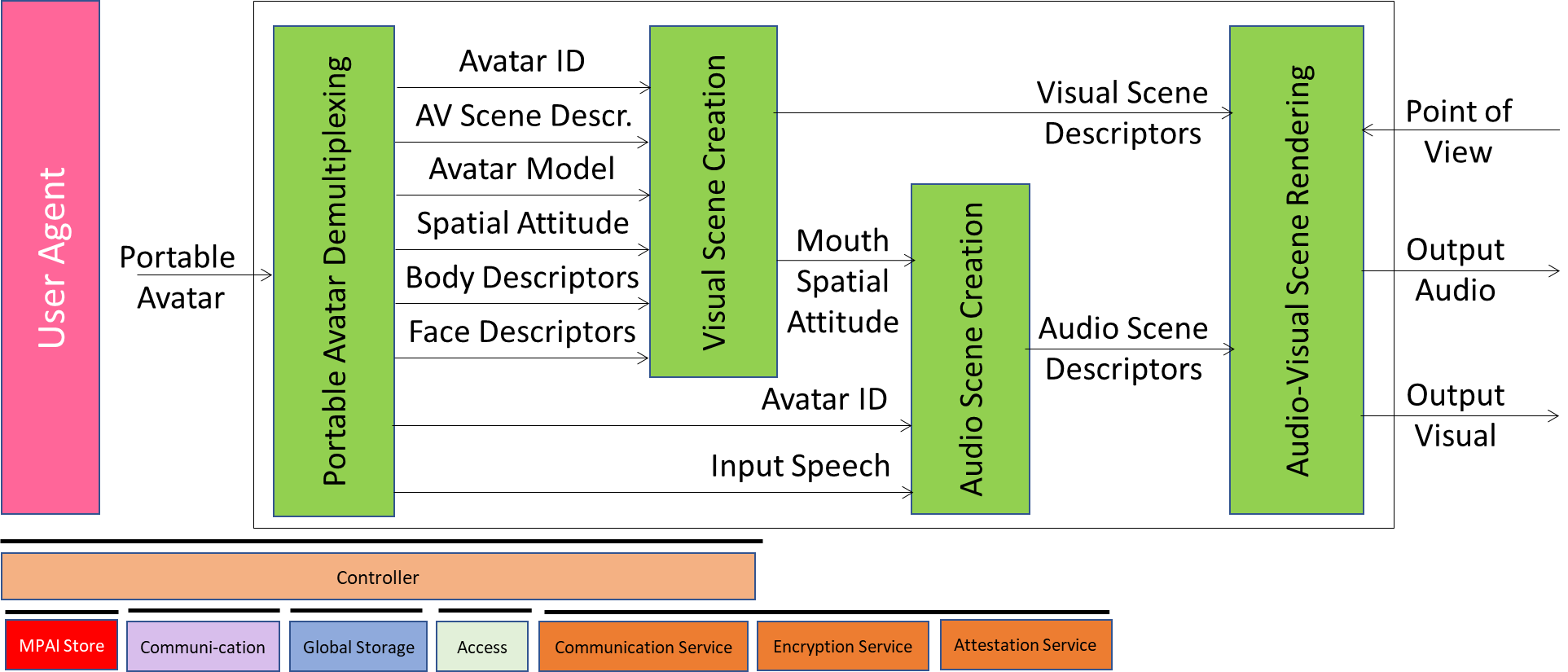6.1 Functions of Client Receiver
6.2 Reference Model of Client Receiver
6.3 I/O Data of Client Receiver
6.4 Functions of Videoconference Client Receiver’s AI Modules
6.5 I/O Data of Videoconference Client Receiver’s AI Modules.
6.6 Specification and JSON Metadata of Client Receiver AIW and AIMs
1 Functions of Client Receiver
The Function of the Receiving Client is to:
- Create the local Audio-Visual Scene using the Avatar Videoconference Server.
- Place and animate the Avatar Models with their Spatial Attitudes.
- Add Speech to Avatars’ mouths.
- Render the Audio-Visual Scene as seen from the Participant-selected Point of View.
2 Reference Model of Client Receiver
Figure 1 depicts the Reference Model of the Videoconference Client Receiver. Red text for data received at the start. This is the operation:
- At the start
- Receives Portable Avatars containing:
- Audio-Visual Scene Descriptors
- Avatar Models
- Spatial Attitudes
- Creates the initial Audio-Visual Scene.
- Receives Portable Avatars containing:
- During the Videoconference:
- Receives the Avatar Models containing:
- Speech
- Body Descriptors
- Face Descriptors
- Creates the running Audio-Visual Scene using each Avatar’s:
- Body and Face Descriptors.
- Speech.
- Renders the Audio-Visual Scene based on the selected Point of View.
- Receives the Avatar Models containing:

Figure 1 – Reference Model of Videoconference Client Receiver
Note: An implementation may decide to display text with a visual image for accessibility purposes.
3 I/O Data of Client Receiver
Table 1 gives the input and output data of Videoconference Client Receiver.
Table 1 – Input and output data of Videoconference Client Receiver AIW
| Input | Description |
| Point of View | Participant-selected point of view to see the Audio-Visual Scene. |
| Portable Avatars | Portable Avatars from Server. |
| Output | Description |
| Output Audio | Presented using loudspeaker (array)/earphones. |
| Output Visual | Presented using 2D or 3D display. |
4 Functions of Videoconference Client Receiver’s AI Modules
Table 2 gives the AI Modules of Videoconference Client Receiver AIW.
Table 2 – Functions of Videoconference Client Receivers’ AI Modules
| AIM | Input |
| Portable Avatar Demultiplexing | Extracts Avatar ID, Audio-Visual Scene Descriptors, Avatar Model, Spatial Attitude, Body Descriptors, Face Descriptors, and Input Speech from Portable Avatars. |
| Visual Scene Creation | Creates the Visual Scene and provides the Spatial Attitudes of the mouths of all Avatars. |
| Audio Scene Creation | Creates the Audio Scene. |
| Audio-Visual Scene Rendering | Provides a ready-to-rendered AV Scene. |
5 I/O Data of Videoconference Client Receiver’s AI Modules
Table 3 gives the AI Modules of Videoconference Receiving Client AIW.
Table 3 – I/O Data of Videoconference Client Receivers’ AI Modules
6 Specification of Videoconference Client Receiver AIMs and JSON Metadata
Table 4 – AIMs and JSON Metadata
| AIMs | Name | JSON | |
| PAF-CRX | Videoconference Client Receiver | X | |
| – | PAF-PDX | Portable Avatar Demultiplexing | X |
| – | PAF-VSC | Visual Scene Creation | X |
| – | PAF-ASC | Audio Scene Creation | X |
| – | PAF-AVR | Audio-Visual Scene Rendering | X |

